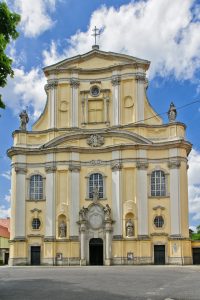Zwiedzanie Kościoła św. Maternusa
Kościół Wniebowzięcia NMP i św. Maternusa w Lubomierzu jest jednym z najpiękniejszych na całym Dolnym Śląsku. O wyjątkowości świątyni świadczy niesamowita architektura i bardzo ciekawa historia. Świątynia ze swoją strzelistą fasadą góruje nad miastem. Fasada jest trzykondygnacyjna. Tym, co najbardziej odróżnia ją od fasad innych należących do czesko-śląskiej grupy kościołów barokowych, jest brak wieży. Najokazalsze freski pokrywają podzielone na trzy części sklepienie nawy głównej. Ich autorem jest William Neunherz. Historia kościoła jest nierozerwalnie związana z historią klasztoru Sióstr Benedyktynek, który W 1810 roku na fali ruchów sekularyzacyjnych został rozwiązany. Budynki poklasztorne stały się własnością państwa Pruskiego. W latach 1845-1946 kościołem opiekowały się siostry Urszulanki. Większość kosztowności zniknęła z kościoła w trakcie i po II wojnie światowej. Istnieją spekulacje, że nie wszystkie skarby zostały odnalezione i część z nich pozostaje ukryta wewnątrz kościoła lub w jego pobliżu. Do dziś w zakrystii znajduje się część kolekcji zabytkowych ornatów z XVII-XIX w. Z tego samego okresu pochodzi wiele spośród użytkowanych do dzisiaj przedmiotów kultu religijnego.
W 2017 roku, na plebanii w Lubomierzu odnaleziono skrzynie z relikwiami świętych i błogosławionych. Ten bezcenny skarb, siostry benedyktynki gromadziły przez cały okres funkcjonowania klasztoru w Lubomierzu. Są to szczątki doczesne świętych, apostołów, agnuski (specjalne papieskie dary), olej św. Mikołaja, a nawet relikwie patrona zakochanych, św. Walentego. Jest to tak duży zbiór, że każdy może odnaleźć tu swojego patrona. Odkryte relikwie pomogły odtworzyć w pewnym stopniu tradycje duchowe kościoła w Lubomierzu. Relikwiarz został umieszczony w bocznej kaplicy kościoła i udostępniony zwiedzającym.

1. Church of the Assumption of the Blessed Virgin Mary and St. Maternus.
The Baroque church of the Assumption of the Blessed Virgin Mary and St. Maternus is the second largest building of this type in Lower Silesia. The temple is divided into two parts:
– Baroque from 1730 – with a monumental altar and numerous 18th century sculptures and paintings. The vault is decorated with frescos and reliefs by G. W. Neunherz.
– the Gothic church from the second half of the 14th century, which preserved, among others, the courtyard and the room of the cloister chapel, supplemented in 1775 with a rich rococo decor.
In addition, in the church you can admire:
– the largest collection in Poland of nearly 300 relics of the first degree, which was found in the rectory in 2016. It contains, among others, the relics of St. Jude Thaddeus, St. Mary Magdalene and St. Ursula
– an exhibition of antique flags and liturgical vestments containing over 100 exhibits, the oldest of which date back to the mid-16th century
The church contains:
– A working and still in use organ from 1797
– On the canopy of the pulpit there is a sculpture of a pelican perched on a globe feeding its chicks with its own blood
– On either side of the altar were placed two glass reliquaries containing the skeletons of the martyrs Benignus and Viktorius
– In the 1960s, a vault with tombs was discovered under the nave of the church. Currently, the entrance is covered by a massive stone slab located under the carpet in the nave between the first pews.
– collection of historic liturgical vestments of the church in Lubomierz. The exhibition consists of 50 chasubles, 13 covers, 2 veils, over 70 stoles and richly decorated banners. The oldest chasubles come from 1550 and the youngest – from 1939. They are presented in the monastery part of the church, which is inaccessible to everyday use. In the 1950s, Karol Wojtyła visited the above-mentioned church while passing through Lubomierz during one of his bicycle excursions.

OSOBY INDYWIDUALNE pragnące zwiedzić: kościół krużganki, „kaplicę mniszek” z przewodnikiem zapraszamy w każdą sobotę (poza uroczystościami kościelnymi) na godz. 10:00
Kościół jest otwierany pół godziny przed Mszami i nabożeństwami.
Msze św. w dni powszednie 17:30 i 18:00
Msze w niedziele 08:00, 12:30, 18:00, oraz o 11:00 w pierwszą i ostatnią niedzielę miesiąca.

Mariä Himmelfahrt und Sankt Maternus – Kirche
Die Mariä Himmelfahrt und Sankt Maternus – Barockkirche ist das zweitgrößte Objekt dieses Typs in Niederschlesien. Der Tempel gliedert sich in zwei Teile:
– Barockteil aus dem Jahre 1730 mit einem monumentalen Altar und zahlreichen Skulpturen und Bildern aus dem 18. Jahrhundert. Das Gewölbe schmücken die Fresken und Reliefs des Meisters G. W. Neunherz
– gotischer Teil aus der zweiten Hälfte des 14. Jahrhunderts. In diesem Teil wurden unter anderem das Viridarium, Kreuzgänge und die im Jahre 1775 mit einer reichen Rokoko – Ausstattung geschmückte Klausurkappelle sehr gut erhalten.
Außerdem kann man in der Kirche noch bewundern:
– die größte in Polen Sammlung von etwa 300 Reliquien der ersten Klasse. Sie wurden im Jahre 2016 im Pfarrhaus gefunden. In dieser Sammlung kann man unter anderem die Reliquien vom Heiligen Apostel Judas Thaddäus, Maria Magdalena und die Heilige Ursula von Köln bewundern
– Ausstellung von Fahnen und liturgischen Gewändern, insgesamt über 100 Requisiten, von denen die ältesten aus der ersten Hälfte des 16. Jahrhunderts stammen
In der Kirche befinden sich auch:
– eine leistungsfähige Orgel aus dem Jahre 1797
– der Baldachin der Kanzel ist von einem auf dem Globus stehenden Pelikan, der seine Küken mit eigenem Blut füttert, gekrönt
– auf beiden Seiten des Altars befinden sich zwei Glassärge mit Skeletten von zwei Märtyrern: Benignus und Viktorius
– In den sechziger Jahren des 20. Jahrhunderts wurde unter dem Hauptschiff der Kirche Keller mit Grabmälern gefunden. Zurzeit ist der Eingang in die Keller mit einer massiven Steinplatte, die sich unter dem Teppich befindet, bedeckt
– eine Sammlung von historischen liturgischen Gewändern aus der Kirche in Lubomierz. Die Ausstellung besteht aus 50 Ornaten, 13 Pluvialen, 2 Schleiern, über 70 Stolen und reich geschmückten Standarten. Die ältesten Ornate kommen aus dem Jahre 1550, die jüngsten aus dem Jahre 1939. Die Requisiten werden alltags im unzugänglichen Klosterteil der Kirche ausgestellt.
In den fünfziger Jahren des 20. Jahrhunderts hielt sich in dieser Kirche Karol Wotyła, der eine Fahrradtour durch Lubomierz gemacht hatte, auf.

Kostel Nanebevzetí Panny Marie a sv. Materna – Významná barokní stavba slezského baroka, dominanta města, která je druhým největším objektem tohoto typu v Dolním Slezsku. Chrám je rozdělen na dvě části:
– barokní, z roku 1730 – s monumentálním oltářem a barokními sochami a obrazy z 18. století. Klenba je vyzdobena freskami a vytesávanými reliéfy, které jsou dílem G. W. Neunherze
– gotickou, z první poloviny 14. století, ve které se zachovalo mimo jiné klášterní nádvoří a klauzurní kaple doplněná v roce 1775 bohatou rokokovou výzdobou.
Kromě toho v barokním kostele můžete obdivovat:
– největší v Polsku kolekci cca 300 relikvií prvního stupně, které byly nalezeny na faře v roce 2016. Jsou to mimo jiné relikvie sv. apoštola Judy Tadeáše, sv. Marie Magdalény a sv. Uršuly
– expozici více než 100 starožitných praporů a církevních rouch, nejstarší pochází z poloviny 16. století
– funkční a dodnes používané varhany z roku 1797
– na baldachýnu kazatelny sochu znázorňující pelikána umístěného na glóbu a krmící svá mláďata vlastní krví
– dva skleněné relikviáře s kostrami mučedníků Benignuse a Viktoriuse po obou stranách oltáře
– hrobky nalezené v 60. letech 20. století pod hlavní lodí kostela v podzemních prostorách. V současné době je vchod do krypty mezi prvními lavicemi v hlavní lodi kostela zabezpečen masivní, kamennou deskou přikrytou kobercem
– sbírku starožitných církevních rouch a šatů, které patří kostelu v Lubomierzu. Expozice se skládá z 50 ornátů, 13 pluviálů, 2 vél, více než 70 štol a bohatě vyzdobených vlajek a korouhví. Nejstarší ornáty pocházejí z roku 1550 a nejnovější z roku 1939. Exponáty jsou vystavovány v běžně nedostupné klášterní části církevních staveb.
V padesátých letech 20. století v průběhu cyklistického zájezdu kostel navštívil Karol Wojtyła.
